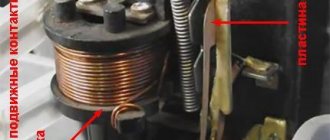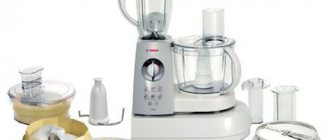The blender is a little multi-functional wizard that has made it easier for women to work in the kitchen. Smoothies, cream soup, purees for children, airy dough for pancakes, pates - a compact submersible machine can handle this perfectly. The stationary unit has enough power to turn meat into tender minced meat, chop ice for cocktails, cut or grate vegetables (if you have the necessary attachment) and much more.
But, like any technology, the blender is equipped with a fragile mechanism, and if you use it incorrectly, you will soon return to your old friend the grater.
Some foods absolutely cannot be ground in a blender! Which? Read below.
Frozen fruit
Who doesn't love energizing fruit drinks? As long as they're fresh, knives do a great job cutting through the tender pulp, but what if you only have frozen fruit? Some people are so confident in the power of the blender that they throw frozen fruit into the bowl. It's good if you get a sorbet... In the worst case, the blades will break or become dull, and the glass (or plastic) of the container will crack. Remove the food from the freezer in advance and leave it for half an hour.
Stationary blender
Let's talk about how the product works. The knife rotates quickly in the bowl, where the chopped products are placed. A specific blade causes the contents to move along a closed path. The knife is located at the bottom. When the electric motor transmits torque to the blade through the output shaft and spindle, the blade's revolutions quickly increase. Due to the speed (thousands of revolutions every minute), the effect of movement of the crushed mass is obtained. The envelope of the blender blade resembles a propeller. The cross pulls fruits and vegetables on top of itself, and throws crushed pieces to the sides.
Then the profile of the bowl comes into play, twisting the movement of the food mass. The walls expand upward, so under the pressure of the flow coming out of the knife, the mash begins to creep upward. In the center, pieces of food fall down. The processed mass reaches the lid and falls back onto the knives. The described process proceeds at a speed beyond the grasp of the eye.
The considered cycle occurs ideally in strong blenders. Cheap household models do not have enough revolutions to establish closed motion. The knife cuts the void. Therefore, wanting to chop the cabbage, the cook is forced to add water. The step releases the laws of hydrodynamics, which come into play, making the work of the knives easier. So first! Before fixing the blender (which may not have broken):
- If a low-power blender does not want to grind the mass, the fact does not indicate a 100% malfunction. Try adding water, milk, juice, and repeat the process.
- A simple fact means: the blade of the blender is dull, the speed switch is broken, the engine lacks the necessary power. The masters say: the problem affects the bowl. More precisely, it lies in the rotating joint of the knife.
In our case, it is recommended to start with a speed test. There are simply up to ten positions of the regulator, you need to go through fixed places one by one, assessing by ear whether the blender blade is moving faster or slower.
Hard grains and nuts
Only truly desperate housewives will stop grinding coffee beans, beans, mung beans or cocoa beans in a blender. To grind hard products, it is better to use a good coffee grinder with a powerful motor and reinforced blades.
A Brazilian travels 36 km by bike every day to take his loved one home.
"Dad is offended." Agata Muceniece about her relationship with Priluchny after the divorce
Women's jeans: before you buy them, you need to pay attention to one detail
How to properly clean the case
There are already models on the market that can be completely submerged in water, but most blenders will immediately break due to this procedure. If the instructions for your device do not indicate whether it can be wetted, do not do this under any circumstances.
To clean the case (usually plastic), gently wipe it with a damp sponge and a drop of detergent. Make sure that moisture does not get into the joints. After cleaning, be sure to wipe the device with a dry, clean cloth.
Dirt often hides between the buttons and in the cracks of the case. A damp toothbrush or toothpick will help you deal with it. Do everything carefully, with a minimum of moisture.
Products with strong aroma
The smell of garlic and the bitterness of chilies and onions can be absorbed into the rubber seal and ruin the taste of the product you are mixing. You may have noticed that raw garlic in the blender jar overnight, even after two or three rinses, still leaves a subtle aroma. A morning cocktail with strawberries and piquant garlic is unlikely to please your taste.
Replacing the blender blade
As for the blender knife, it is unlikely that you will be able to sharpen the blade at home by hand. Buy a new one, there are 3 scenarios waiting for you:
- Firstly, the knife is sold as a separate spare part. In this case, remove the old one. An old, clean towel will help. Wrap a rag around the blender blade and unscrew it from the spindle. Please note: the thread is left-handed, so you need to twist it in the opposite direction than traditionally. It happens that the knife is mounted using several nuts. A wrench and pliers will help you remove the accessory from the blender. The bowl has been removed from the output shaft, the plug has left the socket. The rotating blade of the blender can easily disfigure your fingers, and it will be difficult for doctors to put them back together. It happens that the knife is sold together with the oil seal, change both parts.
- It happens that to dismantle the knife, it is necessary to disassemble the blender bowl. A rare case. Replacement takes place using the described method; take the trouble to update the oil seal covering the spindle.
- Finally, it was discovered that the bowl was not removable. See how to proceed. For such blenders, you will have to change the bowl along with the knife and seal.
Bones
Professional cooks say that inexperienced cooks often make this mistake. When adding chicken or fish to a blender to make mince for meatballs or fish pies, it is important to make sure there are no bones in the meat. Household harvesters are different from industrial ones - even small bones are too much for them.
A student at the Vietnam Police Academy shared how she takes care of her facial skin.
It’s good to wash often: myths about shampoo and hair care that only harm
The money tree pleases with lush flowering: my secret is in caring for the leaves
How to properly wash bowls and attachments
Simply wiping with a sponge is not enough. Residues of food often get clogged under the fastenings of the nozzles; pieces of meat are wound around the rotor after preparing minced meat. Often the base with an adapter shaft on the bowl does not provide for removal. The results are an unpleasant odor, plaque and scratches, excessive load on the motor, corrosion of the motor and board. But under no circumstances should you immerse the blender in water, so what should you do?
Try a simple and universal method: pour water into the bowl and turn on the grinding mode at minimum power. This will help flush out any remaining food from hard-to-reach places. Here are some simple tips:
- use boiled water - fill 2/3 of the bowl;
- add just 1 drop of detergent;
- try putting 2-3 thin slices of lemon into the solution. This will help eliminate the smell of meat or fish and ensure that the knives are cleaned with zest.
After the initial cleaning, you need to drain the water and then repeat the procedure using clean liquid or disinfectant solution. The attachments are easier to clean - they need to be carefully removed and rinsed thoroughly under running water.
If you still missed the moment, and the dirt has already dried, then use baking soda (about 2 tsp) and vinegar (50 milliliters) during cleaning. If the stains are very strong, first soak the bowl in this mixture overnight.
If your blender comes with a glass container, everything is a little simpler - it can be washed in the dishwasher. The regular cycle does an excellent job of removing all contaminants. But plastic will quickly fade if you wash it in a machine.
Sun-dried tomatoes
Unless you have a high-performance, high-speed blender, never try to puree sun-dried tomatoes; their tough skins will stick to the blades. If you still need sun-dried tomatoes, for example for sauce, soak them in water until they soften.
“We are still friends”: Derevianko commented on the breakup with his wife
Rare shot: Viktoria Isakova showed her grown-up daughter from Yuri Moroz (new photo)
Lost weight: what Sofia Tarasova sacrificed for the sake of “VIA Gra” (new photos)
General principles of care
With the right approach to operation and cleaning, the equipment is quite capable of serving for years. Especially considering that parts for almost any model of hand blender are now available. You can change the knife, any body element, seal, or even the electronic board in time to continue using the device. In order for the device to function properly, it must be cleaned regularly.
Whatever one may say, you will have to wash the attachments, knives and bowl after each use. The body and cover should also not be ignored. They need to be cleaned very carefully and relatively rarely - once or twice a month (with active use).
Some more general tips:
- The Max mark on the bowl is not just a dash, but really the final limit up to which you can load products. Otherwise, overloading the device will lead to wear on the motor, and the blender will last much less than it could;
- The seal also requires attention. Gently lubricate it with vegetable oil from time to time to avoid drying out and extend its service life;
- Never leave your blender dirty, especially if it has a plastic bowl. Otherwise, you are guaranteed an unpleasant odor, and it is extremely difficult to wash dried food residues from the submersible nozzle;
- Find a dry and clean place to store the device. Do not leave it on a work surface where it is exposed to dust, splashes of water and grease.
The main thing is to protect the case from moisture getting inside. This is the most common reason for the “premature death” of an excellent electrical appliance.
What can you grind with a blender?
A kitchen blender and chopper greatly simplifies the life of every housewife. Its capabilities allow you to prepare minced meat or chop vegetables without much effort and without getting your hands dirty.
The chopper attachment for a blender with a power of less than 500 W is intended for slicing boiled vegetables, herbs or cheese. The high power of the motor allows you to process meat, hard vegetables, fruits, nuts and even crush ice.
Some devices with additional attachments can even replace graters and shredders in the kitchen. Why are there models that can cut vegetables for salad into cubes? But even the most simple machines are quite capable of chopping vegetables for seasoning soup or stew.
Smeg blenders - reliable and beautiful
Smeg produces several types of blenders, and each of them can be an excellent replacement for a broken one. If you want an inexpensive model, you can purchase an immersion blender with a single attachment. It has a combined body: the upper part is made of plastic, the lower part is made of metal. Device power – 700 W. This is quite enough for preparing sauces, creams, and puree soups. Stainless steel knives with the FlowBlend system can chop products of various consistencies. The model has several operating modes, including Turbo mode. The operating time should not exceed 30 seconds, but usually the food is chopped much faster.
For those who find one attachment not enough, Smeg offers a more advanced immersion model. These blenders have the same power, but their equipment has been significantly expanded. In addition to the traditional attachment, they have a whisk for whipping, plastic gray knives with slow rotation technology - with their help you can prepare any vegetable puree, including potato puree. Owners also get a chopper with a 0.5-liter bowl and a large 1.4-liter bowl that can be used to mix dough, whip up ingredients for pancake batter or omelettes. The blender weighs 2 kg, it does not slip out of your hands and copes well with a traditional set of tasks.
The Smeg retro series has a stationary blender with a spacious one and a half liter jug. The model has non-slip rubberized feet and a measuring cup is included. Like immersion blenders, there are multiple speeds available. Additional functions worth mentioning are making puree, crushing ice and turbo mode. The power is slightly higher than previous models - 800 W.
Separately, it is worth noting the retro-style design of the models. Their body can be painted white, silver, black, cream, red, blue, pink or green. And for connoisseurs of original design, there is a model with an original pattern developed by the famous duo Dolce & Gabbana. This blender can decorate the most sophisticated kitchen interiors.
Types of blenders and their design
There are two main types of devices: submersible and stationary. The first option is a fairly compact solution, the components of which are a bushing, a cutting or grinding attachment and the device itself. The head part can be connected to various attachments or bowls. The immersion blender has quick assembly, versatility, compactness and fairly high maintainability.
The stationary version has a different design. It consists of a main body and a bowl. The main body, which houses the engine and other important structural elements, is located at the bottom. The bowl is installed on it, after which the device starts up. The advantage of the stationary option is high power and large capacity. The downside is that it is difficult to repair if the bowl or other parts break.
Types of knives used for chopping in a blender
The blender blade may have two or four small protrusions arranged in a circle. They differ in appearance and purpose.
- Nozzle with sickle-shaped knives . Rounded steel blades are used for preparing puree, minced meat, and curd mass.
- Nozzle with grater . Used for chopping vegetables for salads and soup dressings. Steel knife with holes in the surface.
- Chopper knife for crushing ice . Features more durable steel.
Possible breakdowns and solutions
Now you can consider which breakdowns are most common and what to do to fix them.
Doesn't shred
In some inexpensive models, the process may not be efficient enough; the knife rotates more idle. As a result, it is worth adding a little water to the bowl. For example, if you need to chop cabbage. This will allow you to achieve better grinding results.
Therefore, if there is such inefficiency, this does not mean that the device needs repair.
In this case, contact with the knife may be lost, engine power may be reduced, the speed controller may be broken, or the knife may become tangled. Therefore, it is worth assessing by ear whether the speeds are switched. The higher the speed, the noisier the knife should work.
Perhaps the knife was simply dull. And in this case, sharpening it at home is usually impossible. Therefore you will have to buy a new one. And then there are three ways to solve the problem:
- If you purchase the knife as a separate part, you can change it yourself. First, using a towel, remove the old one, having first removed the bowl and unplugged the device. Left-hand thread is used here. In some cases, several nuts are used to secure the knife. Therefore, you may need a key.
- In some models, you have to disassemble the bowl to remove the knife. And then the procedure is similar.
- There are samples in which the bowl and knife are a single unit, so replacing parts will have to be done together.
Doesn't spin
In addition to the described problem with the knife, the speed switch may also be damaged. In this case, repairing the device on your own will be much more difficult - knowledge of electrical engineering is required. The board that is responsible for distributing speeds will have to be removed and all its contacts checked. They must close.
When carrying out repairs, do not forget about an important feature of the device: if the bowl is not installed, the engine will not work.
Does not work
If the blender does not even turn on, the problem can sometimes be solved even easier than in the description above.
So, first we turn on the device.
- If you can hear a buzzing sound, it means that the problem is probably that the knife is not spinning, or rather, something is preventing it. You need to remove the thicket and press the power lock button. If everything works, then the breakdown lies in the knife or bowl.
- Everything is more confusing if the device does not work when the lock button is pressed. Probably engine problems. Most likely, it will have to be changed. If a cheap blender is being repaired, then it hardly makes sense. It will be cheaper and more correct to purchase a new device.
- If there is no buzzing after turning on the blender, then everything is even more complicated. And the first thing you need to do is determine whether there is voltage in the network. How to do it? You can take, for example, a table lamp and plug it into the same outlet where the device was connected. As a rule, the problem is resolved at this stage.
Sometimes the reason the device stops is due to cable damage. To do this you will have to disassemble the case. Inside you need to find a power block to which the cable is connected.
Here you can use a clearly working cord to check or connect a voltmeter. If the quality of the connections does not allow you to implement this step, you can take a needle, solder it to the wire and insert it into the insulation. This must be done with the power off and very carefully.
If the device has a fuse, you can remove it and ring it. If it breaks, we replace it with a new one with the same parameters (indicated on the case). By the way, the fuse slot is perfect for voltage measurements if there is no more convenient access.
If after installing a new fuse it immediately breaks, there is most likely a short circuit in the blender. This may be caused by a breakdown of one of the components. They will have to be connected to the source one by one to determine the “weak link”. Very often this is the motor or the board.
The latter, by the way, is worth the researcher visually. There should be no swollen capacitors or burnt resistors on it. Otherwise, you will need to replace either the broken element or the entire board.
Types of blenders
To understand how to repair a blender with your own hands, you first need to know the principle of its operation. So, today two types of these devices are produced:
- Stationary.
- Manual or submersible.
But there is also a blender, which is part of a large and multifunctional food processor. In this case, if there is a breakdown, the entire device does not work. Therefore, in this article we will only talk about how to calculate the cause of the breakdown and repair a stationary or hand blender.
Hand or immersion and stand blender
Regardless of the model, kitchen utensils have several basic mechanisms that ensure operation. First of all, this is the motor, various knives and attachments, the number and types of which depend on the model, as well as the bowl. In some of them she can play a remembering role.
Immersion blender
A cane-shaped device equipped with several attachments. Its main difference from the stationary one is the absence of a thicket. At the same time, this allows housewives to perform all manipulations in a variety of containers. Its body contains the following:
- engine;
- spindle;
- Control block.
Stationary blender
During his work, the cook's hands are free. The device has a base on which a bowl is installed. The cutting attachments are located in it. Repairing this type of device is somewhat more difficult due to the presence of a large number of parts. It consists:
- bowl with lid. It can be glass or plastic, depending on the model;
- engine;
- spindle;
- knife;
- drive shaft;
- locking mechanism.











